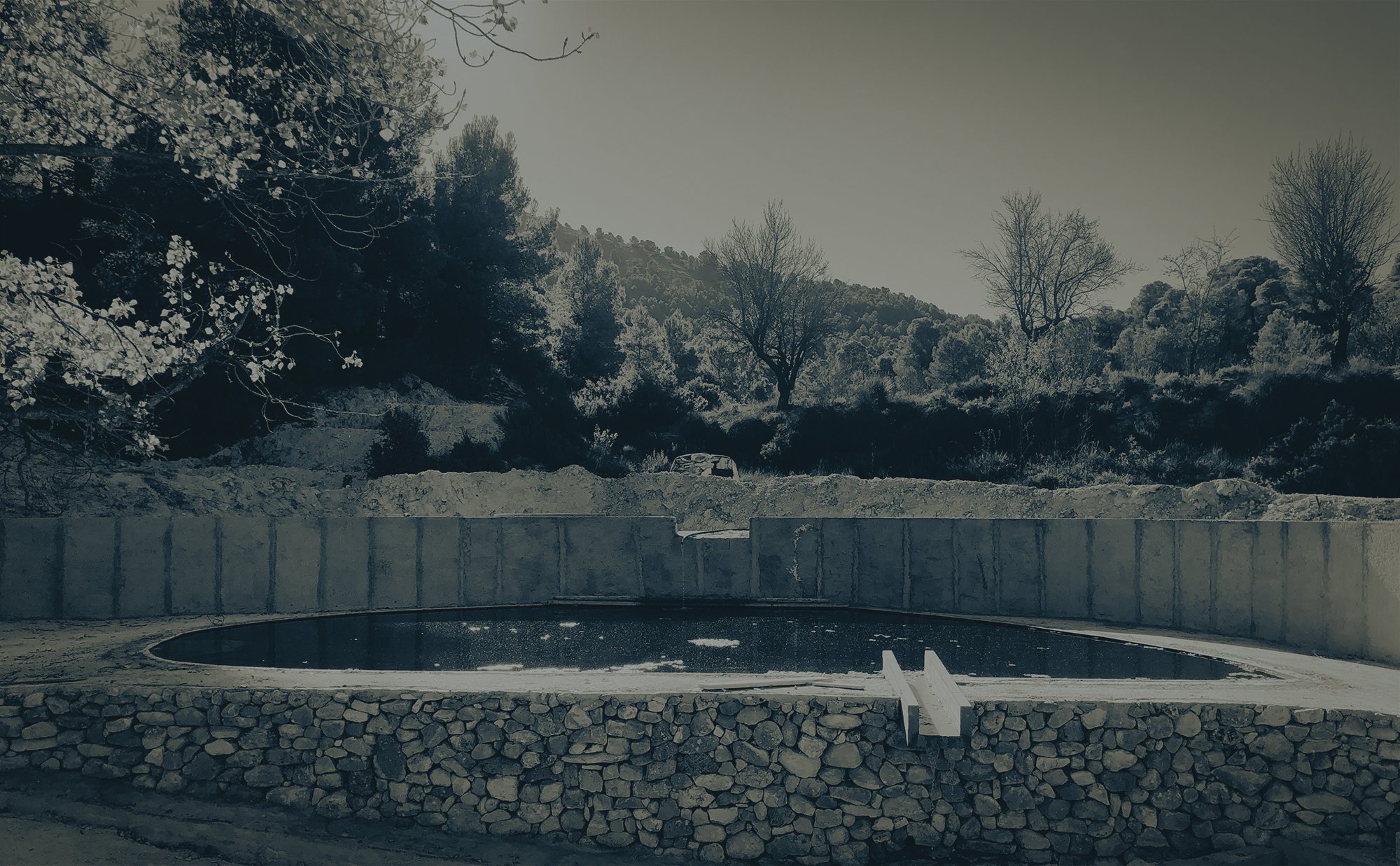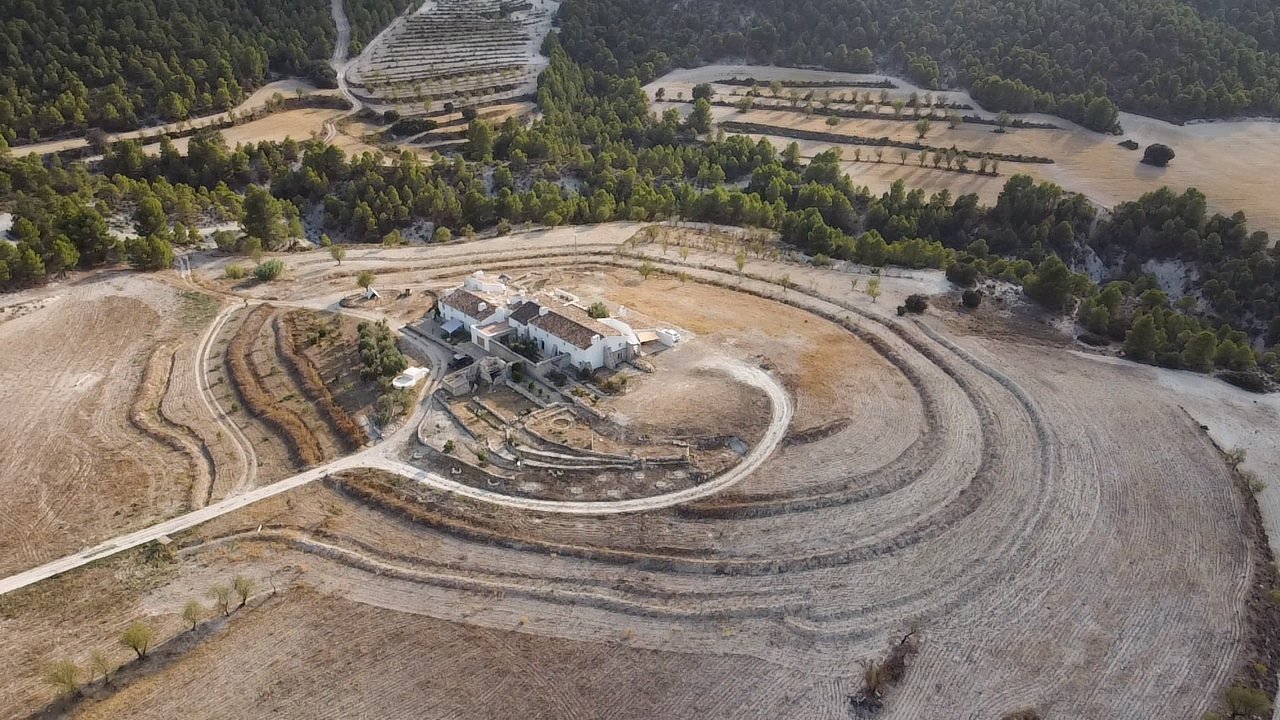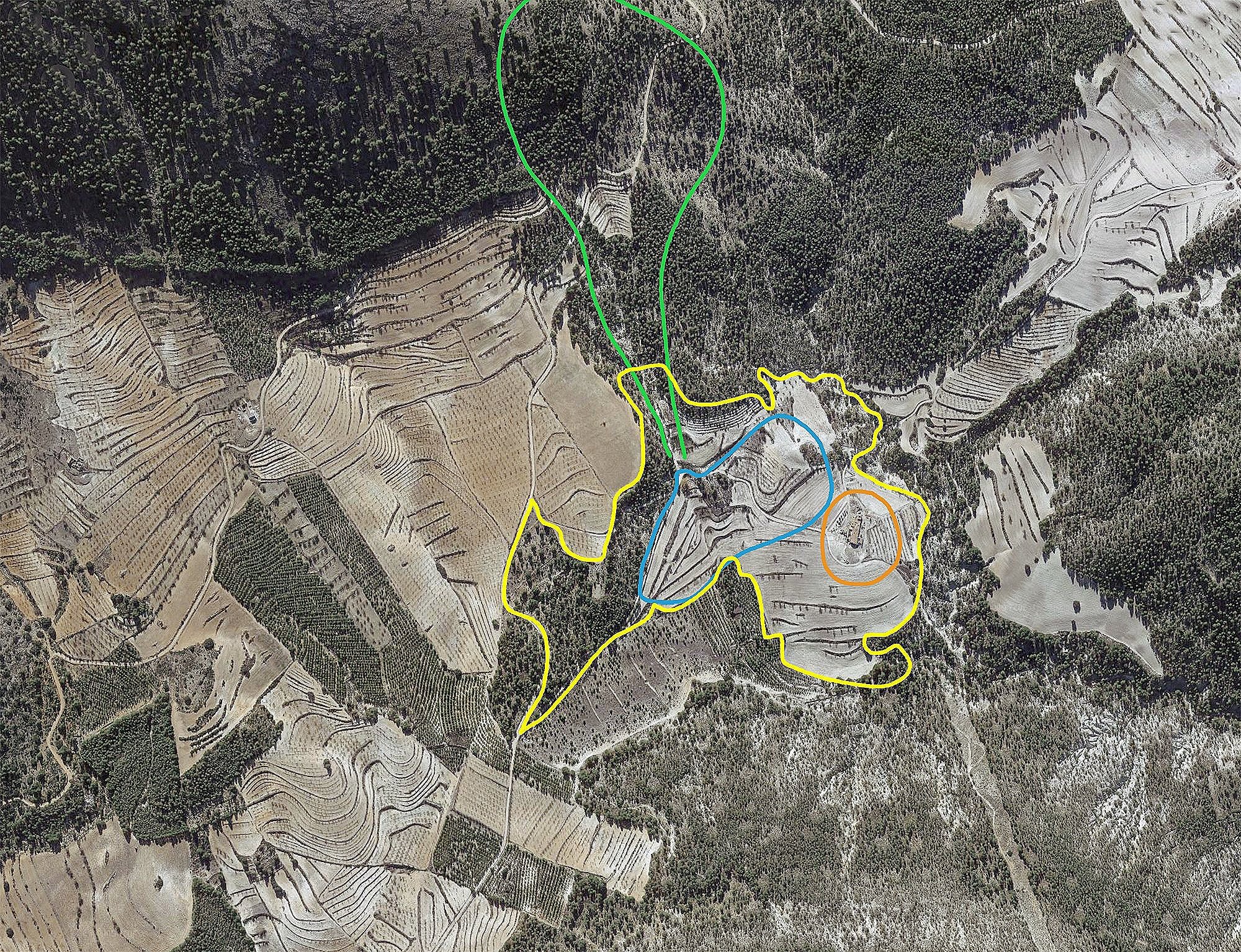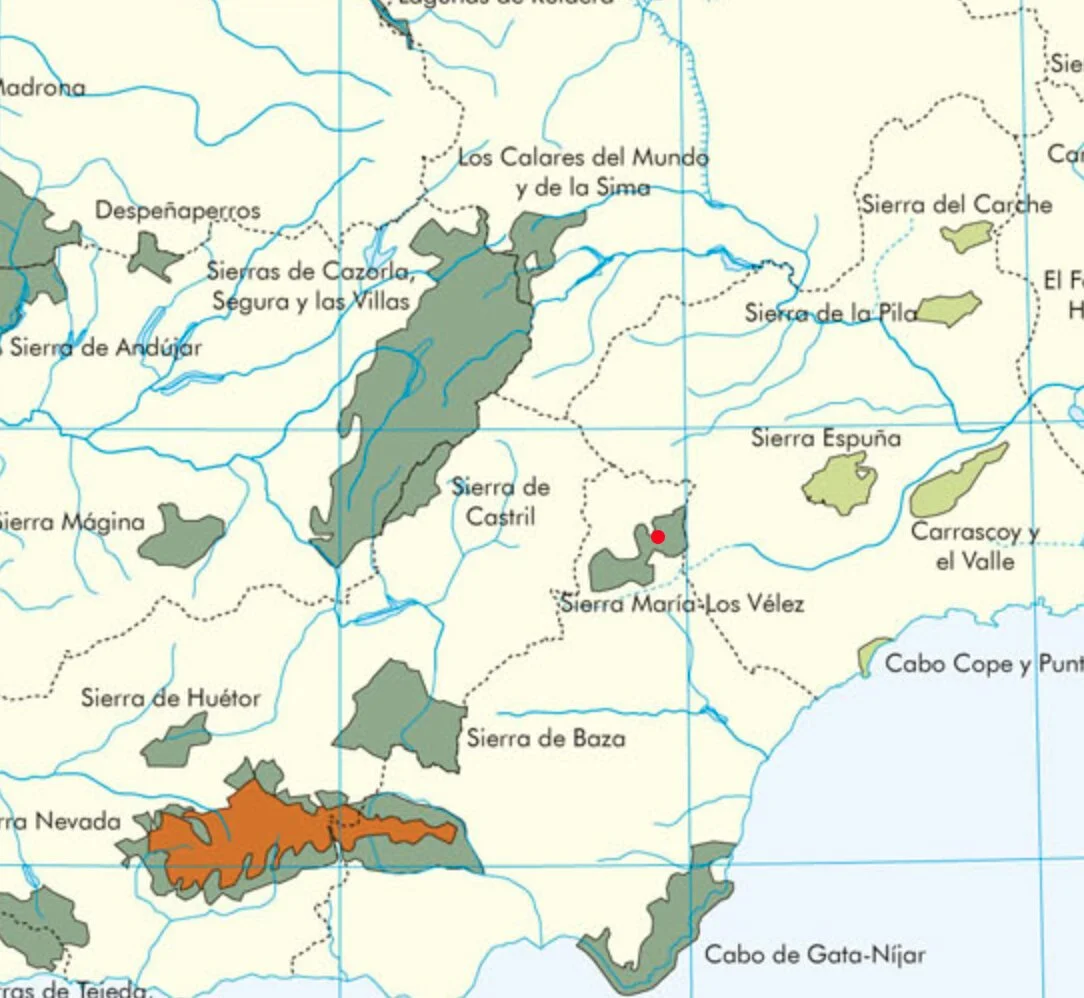
deposition (WiP) restore brief…
(updates to be found at the bottom of the page)
location: Parque Natural Sierra María - Los Vélez
37.76339, -2.06833
altitude: approximately 1000m
area: approx 20 hectares
contents:
- landscape character assessment
- restoration project
part 1 / the creation of a food forest
part 2 / the restoration of the water catchment system
part 3 / reforesting
landscape character assessment:
classification:
KöppenGeiger BSk - cold semi arid changing to BWh - hot desert
average temperatures 13.1º C average rainfall 352mm
biome: mediterranean steppe / chaparral / Iberian conifer forest / semi-deciduous forest / sclerophyllous vegetation
Forests of holm oak (Quercus rotundifolia) were once predominant in plains and valleys with deep alluvial soil. Over centuries these forests have been converted to agriculture, pasture or maquis scrubland, a dense thicket of tall woody shrubs and low trees, mixed with low shrubs, herbs, and grasses.
In the heart of a natural park of sedimentary limestone, marl, and gypsum-derived soils we are home to a mosaic landscape, with extensive mixed forest of Aleppo pine (Pinus halepensis) and holly oak (Quercus coccifera), open juniper woodlands of Juniperus thurifera and Juniperus phoenicea, steppe grasslands with Stipa tenacissima and Lygeum spartum, and low shrublands with Artemisia herba-alba, Thymelaea hirsuta, Ononis tridentata, Helianthemum squamatum, and Thymus mastigophorus.
history: this was once a mixed almond / cereal subsistence small holding / chickens / rabbits and pigs + wild game. Additionally it benefitted from a water catchment system (cañada y boquera) used principally for cordero segureño (sheep and goat grazing) and vegetable / fruit trees.
The farm was abandoned in the late 1960s early 1970s falling into disrepair...
Ubicación: Parque Natural Sierra María - Los Vélez
37.76339, -2.06833
altitud: aproximadamente 1000m
área: aproximadamente 20 hectáreas
contenido:
- evaluación del carácter del paisaje
- proyecto de restauración
parte 1 / la creación de un bosque alimentario
parte 2 / la restauración del sistema de captación de agua
parte 3 / reforestando
evaluación del carácter del paisaje:
clasificación:
KöppenGeiger BSk - frío semiárido cambiando a BWh - desierto caliente
temperaturas medias 13,1º C precipitaciones medias 352mm
bioma: estepa mediterránea / chaparral / bosque ibérico de coníferas / bosque semicaducifolio / vegetación esclerófila
Los bosques de encina (Quercus rotundifolia) predominaban en las llanuras y valles de suelos aluviales profundos. A lo largo de los siglos, estos bosques se han convertido en agricultura, pastos o matorrales de maquis, una densa espesura de arbustos leñosos altos y árboles bajos, mezclados con arbustos bajos, hierbas y pastos.
En el corazón de un parque natural de suelos sedimentarios calcáreos, margas y yesíferos albergamos un paisaje en mosaico, con extenso bosque mixto de pino carrasco (Pinus halepensis) y encina (Quercus coccifera), sabinares abiertos de Juniperus thurifera y Juniperus phoenicea, pastizales esteparios con Stipa tenacissima y Lygeum spartum, y matorrales bajos con Artemisia herba-alba, Thymelaea hirsuta, Ononis tridentata, Helianthemum squamatum y Thymus mastigophorus.
historia: esto fue una vez una pequeña propiedad de subsistencia mixta de almendras / cereales / pollos / conejos y cerdos + caza salvaje. Adicionalmente se benefició de un sistema de captación de agua (cañada y boquera) utilizado principalmente para cordero segureño (pastoreo de ovejas y cabras) y hortalizas/frutales.
La granja fue abandonada a fines de la década de 1960 y principios de la de 1970 y se deterioró…

satellite view of the subject area the boundaries indicated in yellow / vista satelital del área temática los límites indicados en amarillo

ochre areas are almond plantations / gray areas are abandoned farmland / green areas are forests
las zonas ocres son plantaciones de almendros / las zonas grises son tierras de cultivo abandonadas / las zonas verdes son bosques

the situation is called La Hoya de Carrascal referring to the encina carrasco
la situación se llama La Hoya de Carrascal refiriéndose a la encina carrasco
restoration project:
part 1 / the creation of a food forest built on permaculture design principles of a series of swales and berms in the immediate vicinity of the cortijada. In excess of 200 trees planted in the last four years including olive / apple / cherry / mulberry / pear / persimmon / medlar / quince / fig / jujube / almond / hazel nuts etc. These trees are currently being established via drip irrigation.
parte 1 / la creación de un bosque de alimentos basado en los principios de diseño de la permacultura de una serie de cunetas y bermas en las inmediaciones de la cortijada. Más de 200 árboles plantados en los últimos cuatro años, incluidos olivos, manzanos, cerezos, moreras, perales, caquis, nísperos, membrillos, higos, azufaifo, almendras, avellanas, etc. Estos árboles se están estableciendo actualmente mediante riego por goteo.

keyline landscape modifications (swales and berms on contour) around the residency for the creation of a food forest / modificaciones key line del paisaje (zanjas y bermas en el contorno) alrededor de la residencia para la creación de un bosque de alimentos
part 2 / the restoration of the water catchment system (cañada y boquera). We have an ancient water catchment system which, as a consequence of land abandonment, has fallen into disrepair and is currently un-productive. The water catchment system is divided into two sections. Section 1 (Cañada) the upper section is the adaptation of an erosional channel (barranco) via the construction of earthwork check dams which put the brakes on water run-off interrupting hydrological cycles creating a subterranean aquifer which slowly continues it’s path down the mountain until it reaches the point of deposition (where the force of water movement changes from erosive to deposition). Section 2 (boquera) at the lower section the point of deposition, or keypoint, is the location of an irrigation tank (embalsa). This area lies between two primary ridges and is the terraced adaptation of the primary valley. Irrigation water is distributed via small canals (acequias) via the force of gravity to selectively water individual terraces when needed. When functioning the system produced up to 20,000 litre per day.
parte 2 / la restauración de la red de captación de agua (cañada y boquera). Contamos con un antiguo sistema de captación de agua que, como consecuencia del abandono de terrenos, se ha deteriorado y actualmente es improductivo. El sistema de captación de agua se divide en dos secciones. Sección 1 (Cañada) la sección superior es la adaptación de un canal de erosión (barranco) mediante la construcción de diques de contención de movimiento de tierras que frenan la escorrentía del agua interrumpiendo los ciclos hidrológicos creando un acuífero subterráneo que lentamente continúa su camino montaña abajo hasta alcanza el punto de deposición (donde la fuerza del movimiento del agua cambia de erosión a deposición). Sección 2 (boquera) en la sección inferior el punto de deposición, o punto clave, es la ubicación de un tanque de riego (embalsa). Esta área se encuentra entre dos crestas principales y es la adaptación en terrazas del valle principal. El agua de riego se distribuye a través de pequeños canales (acequias) a través de la fuerza de la gravedad para regar selectivamente las terrazas individuales cuando sea necesario. Cuando funcionaba, el sistema producía hasta 20.000 litros por día.

yellow: boundary / green: cañada / blue: boquera / orange: food forest. - amarillo: límite / verde: cañada / azul: boquera / naranja: bosque de alimentos
current status:
Land abandonment along with increasingly intense rainfall created erosional fissures in the terraces allowing water to escape the catchment. 40% of the cañada has now been restored.
The irrigation tank (embalsa) has been re-built and an additional pond has been added to the system for a two fold use natural pool and irrigation water for an organic vegetable garden.
In the year since we started the restoration of the cañada we have not seen significant increase in water catchment.
Once restored there is no reason for the water catchment system not to work again.
water:
We have access to water within the lower reaches of the water catchment system, permission being given by the Confederación Hydrográfica del Segura. The perforation is 100m deep and yields enough water to fill an aljibe (20,000 litres) at the cortijada. Using drip irrigation on our fruit trees in summer plus domestic water for the residency we only just have sufficient water.
part 3 / reforesting
Joya: arte + ecología / AiR is a residency for international artists and writers. We developed sustainable and cultural activity as, in part, the economic means to regenerate land. Land fallen out of agricultural use but, given this climate, unable to regenerate itself apart from the Aleppo pine which has colonised a lot of abandoned land in the mountains. We don’t consider these pines to be regenerative, more opportunist. What they leave you with is a monoculture of species, susceptible to pest and fire and in terms of fauna diversity very poor.
The residency is off-grid and carbon neutral, but we wanted to go further and be carbon positive. Given the nature of our cultural and sustainable activities it appeared to us that our resident artists might benefit more from returning the land to the native steppe ecology found here 200 years ago. Encounters with native flora and fauna was going to be more beneficial to us and our resident artists both economically and experientially. However, 20 hectares of land in this climate and topography couldn’t meaningfully support animals higher up the food chain. Consequently, how could we hope to benefit from the altered and improved landscape we wished to achieve as a consequence of trophic cascades? Well, we are fortunate enough to be in the heart of a 22,000-hectare natural park. In addition to the north the land is underpopulated extending the areas wildlife could range even further. Our land is bordered by common land, forested mountains all around us. What we could achieve is to be a bridge or corridor between more native habitats. However, we don’t want to replicate that habitat in an unending forest of Aleppo pine, we want to create a landscape more beneficial to flora and fauna. This landscape is already rich in raptors, reptiles, vultures, passerine birds and mammals. The adjacent province of Murcia has given us a head start with the re-introduction of the Spanish Lynx… this in addition to the now established reintroduction of the Lammergeier to the north in the Sierra Cazorla and we are on the way.
estado actual:
El abandono de la tierra junto con lluvias cada vez más intensas crearon fisuras erosivas en las terrazas que permitieron que el agua escapara de la cuenca. Actualmente se ha restaurado el 40% de la cañada.
Se ha reconstruido el depósito de riego (embalsa) y se ha añadido un estanque adicional al sistema para una piscina natural de doble uso y agua de riego para una huerta orgánica.
En el año desde que comenzamos la restauración de la cañada no hemos visto un aumento significativo en la captación de agua.
Una vez restaurado, no hay motivo para que el sistema de captación de agua no vuelva a funcionar.
agua:
Tenemos acceso al agua dentro de los tramos inferiores de la red de captación de agua, siendo autorizado por la Confederación Hidrográfica del Segura. La perforación tiene 100 m de profundidad y arroja agua suficiente para llenar un aljibe (20.000 litros) en la cortijada. Usando riego por goteo en nuestros árboles frutales en verano más agua doméstica para la residencia, solo tenemos agua suficiente.
parte 3 / reforestando
Joya: arte + ecología / AiR es una residencia para artistas y escritores internacionales. Desarrollamos la actividad sostenible y cultural como, en parte, el medio económico para regenerar la tierra. Terrenos caídos en desuso agrícola pero, con este clima, incapaces de regenerarse aparte del pino carrasco que ha colonizado muchos terrenos abandonados en las montañas. No consideramos que estos pinos sean regenerativos, más oportunistas. Lo que te dejan es un monocultivo de especies, susceptible a plagas e incendios y en cuanto a diversidad faunística muy pobre.
La residencia está autosuficiente y es neutra en carbono, pero queríamos ir más allá y ser positivos en carbono. Dada la naturaleza de nuestras actividades culturales y sostenibles, nos pareció que nuestros artistas residentes podrían beneficiarse más al devolver la tierra a la ecología de estepa nativa que se encontró aquí hace 200 años. Los encuentros con la flora y la fauna autóctonas iban a ser más beneficiosos para nosotros y nuestros artistas residentes, tanto económica como experiencialmente. Sin embargo, 20 hectáreas de tierra en este clima y topografía no podrían sostener de manera significativa a los animales que se encuentran más arriba en la cadena alimentaria. En consecuencia, ¿cómo esperar beneficiarnos del paisaje alterado y mejorado que deseábamos lograr como consecuencia de las cascadas tróficas? Bueno, tenemos la suerte de estar en el corazón de un parque natural de 22.000 hectáreas. Además del norte, la tierra está poco poblada y la vida silvestre de las áreas podría extenderse aún más. Nuestra tierra está bordeada por tierras comunales, montañas boscosas a nuestro alrededor. Lo que podríamos lograr es ser un puente o corredor entre más hábitats nativos. Sin embargo, no queremos replicar ese hábitat en un bosque interminable de pino carrasco, queremos crear un paisaje más beneficioso para la flora y la fauna. Este paisaje ya es rico en aves rapaces, reptiles, buitres, aves paseriformes y mamíferos. La vecina provincia de Murcia nos ha dado una ventaja inicial con la reintroducción del lince español… esto además de la ya establecida reintroducción del quebrantahuesos al norte en Sierra Cazorla y estamos en camino.
Whilst we are missing keystone species in this region such as bears and wolves, there are resident populations in Spain so one can only hope. Our neighbouring mountain range is the Sierra del Oso, the sierra of bears. So, they did once live here as did wolves. The Lynx will have to suffice in the short term.
Earlier I mentioned the historic water catchment system on our property. It is technology that dates back to the Bronze Age in this region. It is a landscape adaptation that sustainably harvests water from the hydrosphere. It is within this zone that the farmers grew vegetables and fruiting trees like olives for the household. For me, what is unique about this system is that it is sustainable. The farmers did not extract ancient ground water and the system was co-evolutionary, benefiting both farmer and flora and fauna.
Land abandonment led the catchment system to fall into disrepair but, during Covid lockdown, we have started the restoration of the terraces in the certainty that we can make the system work again. We may have to augment it to deal with climate change driven increases in the incidence of flash floods but like all these projects they are trial and error.
Si bien nos faltan especies clave en esta región, como osos y lobos, hay poblaciones residentes en España, por lo que solo podemos esperar. Nuestra sierra vecina es la Sierra del Oso, la sierra de los osos. Entonces, una vez vivieron aquí como lo hicieron los lobos. El Lynx tendrá que bastar a corto plazo.
Anteriormente mencioné el histórico sistema de captación de agua en nuestra propiedad. Es una tecnología que se remonta a la Edad del Bronce en esta región. Es una adaptación del paisaje que recolecta agua de la hidrosfera de manera sostenible. Es dentro de esta zona que los agricultores cultivaban hortalizas y árboles frutales como aceitunas para el hogar. Para mí, lo que es único de este sistema es que es sostenible. Los agricultores no extraían agua subterránea antigua y el sistema fue coevolutivo, beneficiando tanto a los agricultores como a la flora y la fauna.
El abandono de la tierra hizo que el sistema de captación se deteriorara pero, durante el confinamiento por el Covid, hemos comenzado la restauración de las terrazas con la certeza de que podemos hacer que el sistema funcione nuevamente. Es posible que tengamos que aumentarlo para hacer frente a los aumentos provocados por el cambio climático en la incidencia de inundaciones repentinas, pero como todos estos proyectos, son de prueba y error.

Taking my inspiration from this water catchment design, over the last two years we have built a Keyline water catchment system closer to the house. This is to be our food forest. Strictly following contour lines, we have coincidentally built concentric system of swales and berms around the house on the land that flows away from the property. The intention is for this catchment system to provide enough water to create an area of diverse planting of edible fruits, berries and nuts. The berms act as insectaries, habitats for predatory insects that will discourage pest insects on our fruit. The idea is to try and mimic the ecosystems and patterns in nature found in this region. We have planted over 250 fruiting trees in this zone and we have plans for at least two hundred more.
Ultimately the landscape adaptations, historical or contemporary which we have restored or constructed, create living environments for plant life. In turn these adaptations sequester carbon from the atmosphere with the intention of making us carbon positive. Additionally, the combination of land adaptation, moisture retention and living organisms go a long way to prevent run-off, flooding and erosion.
The restoration of degraded land such as ours is highly effective for both carbon sequestration and re-creating habitats for native wildlife. These are two essential mitigations against climate change. We are not certain yet what we should be restoring our landscape to, but we imagine pre-industrial times. This is a subject for further consultation. We know that simply planting trees is not the solution. What we wish for is the wholesale restoration of ecosystems relative to this climate and geography. Restoring the diversity of plant and animal life is a goal that simultaneously benefits wildlife and the climate.
We aim to show that wilding land and growing food sustainably can be mutually beneficial in reversing species loss and reduce atmospheric carbon dioxide.
Inspirándome en este diseño de captación de agua, en los últimos dos años hemos construido un sistema de captación de agua Keyline más cerca de la casa. Este debe ser nuestro bosque de alimentos. Siguiendo estrictamente las curvas de nivel, coincidentemente hemos construido un sistema concéntrico de cunetas y bermas alrededor de la casa en el terreno que se aleja de la propiedad. La intención es que este sistema de captación proporcione suficiente agua para crear un área de plantación diversa de frutas comestibles, bayas y nueces. Las bermas actúan como insectarios, hábitats de insectos depredadores que disuadirán a los insectos plaga de nuestros frutos. La idea es tratar de imitar los ecosistemas y patrones en la naturaleza que se encuentran en esta región. Hemos sembrado más de 250 árboles frutales en esta zona y tenemos planes para por lo menos doscientos más.
En última instancia, las adaptaciones al paisaje, históricas o contemporáneas que hemos restaurado o construido, crean entornos de vida para la vida vegetal. A su vez, estas adaptaciones secuestran carbono de la atmósfera con la intención de convertirnos en carbono positivo. Además, la combinación de adaptación de la tierra, retención de humedad y organismos vivos contribuye en gran medida a prevenir la escorrentía, las inundaciones y la erosión.
La restauración de tierras degradadas como la nuestra es altamente efectiva tanto para el secuestro de carbono como para la recreación de hábitats para la vida silvestre nativa. Estas son dos mitigaciones esenciales contra el cambio climático. Todavía no estamos seguros de cómo deberíamos restaurar nuestro paisaje, pero imaginamos tiempos preindustriales. Este es un tema para mayor consulta. Sabemos que simplemente plantar árboles no es la solución. Lo que deseamos es la restauración al por mayor de los ecosistemas relativos a este clima y geografía. Restaurar la diversidad de la vida vegetal y animal es un objetivo que beneficia simultáneamente a la vida silvestre y al clima.
Nuestro objetivo es demostrar que las tierras salvajes y el cultivo de alimentos de manera sostenible pueden ser mutuamente beneficiosos para revertir la pérdida de especies y reducir el dióxido de carbono atmosférico.
